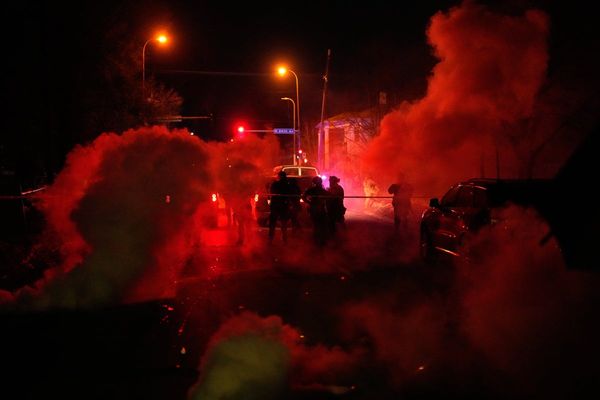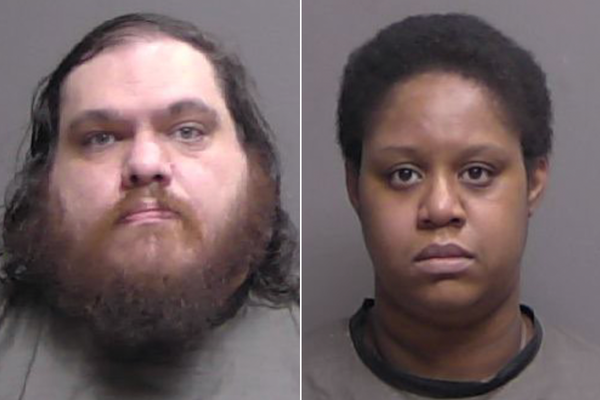
It was the fifth day after this month’s devastating 7.8 magnitude earthquake when George Butler started drawing the Buket apartment block at the heart of the ancient southern Turkish city of Antakya.
A few miles from the quake’s epicentre, the eight storey building with four flats on each floor had collapsed when the building next to it fell into its northern wall. As Butler made his drawing, only 20 people had been recovered from the rubble. Many, many more were trapped, most likely dead. And this was before this week’s two additional earthquakes, one of 6.4 the other of 5.8 magnitude, hit the Hatay province of which Antakya is the capital.
“We wait,” said Macit, a young medical student from Istanbul, who spoke to Butler at the scene the Englishman was sketching. Macit was with his father on the street, hoping their cousin, his wife and the couple’s child would be rescued. “With every hour that passes that seems more unlikely,” says Butler. “However that’s not the only point at this stage – finding the bodies at all is what many are praying for.”
Moustapha was waiting for news of eight family members when he invited Butler to lean on his car boot to draw this image. An eight-year-old girl called Asma, who Butler describes as having “a smile that could make you cry”, was waiting with her father for her uncle, his wife and their nine-year-old boy. Fahit, 35, plied Butler with sugary tea while waiting to learn the fate of his cousins.

The 37-year-old Butler is a veteran reporter from disaster zones. He’s made drawings in Ukraine, in Gaza at the 2017 liberation of Mosul, in the Bekaa Valley’s refugee camps and in Azaz, one of the many Syrian towns obliterated in that country’s civil war. But this is the first time he’s confronted the human tragedy inflicted by natural disaster.
“I naively assumed there would be pockets of normality,” he says. “But nothing was normal, everything was destroyed.” Antakya, perhaps better known in the west as Antioch, was founded by the Seleucids in 300BC and has since had a long and troubled history, being besieged, battled over and ruled by all kinds of people: Romans, Persians, Byzantines, Christian crusaders, Mamaluks, the French, Ottomans. But after the quakes a cry is heard regularly on the streets – “Antakya bitti” (Antakya is finished). Maybe it isn’t – Antakya has, after all, suffered many earthquakes in its long history – but the kind of devastation Butler depicts surely shows it will take many years to reverse that impression.
Across the nearby border, in northern Syria, a land Butler knows well, life has already been shattered by more than 11 years of civil war. Added to the human cost there is spiralling homelessness as a result of the quake – about 5.3 million people will lose their homes as a result of the quake, according to UNHCR estimates. Many of those are living in tents or other makeshift accommodation in the midst of a bitterly cold winter.
Butler didn’t go to this part of the world to report on the disaster but to meet local partners for the charity he helped set up a decade ago called Hands Up. Since 2013 it has raised £6m for health and education programmes in Syria and neighbouring countries. “That part of Turkey services everything we do in Syria so it was important for me to go and speak with partners on the ground. The reality of it was quite different when we got there. Everybody was leaving. There was nowhere we could meet. So I made some drawings instead.”
The first drawing he did on arrival depicts the funeral of a friend. “By the time I got there I learned that the person I had first gone to Syria with 10 years ago, this very sweet man called Anas, had died.” Anas Sweid, 30, was the operations manager with humanitarian charity Care International. He died in the earthquake along with his wife, Lana, and daughter, Layal.

Butler’s drawing depicts the heart-rending scene at the cemetery where diggers are backfilling graves and little pockets of mourners all around the graveyard are burying loved ones. Butler made his drawings in pen and ink and then brought them back to his studio in Bermondsey, south London, to finish them with colour washes.
Hands Up has now raised £165,000 for its Emergency Earthquake Appeal, with, so far, £80,000 spent on staff wages at clinics, self-dialysis kits and baby formula. “We’re very tuned in to what people need on the ground and we respond to what they say is needed.”
Next month Butler returns to the war in Ukraine, from where he has already sent some powerful images, including one particularly poignant drawing of a 99-year-old deaf and blind woman called Madame Olga. He drew her last year in the Kyiv apartment that, despite artillery fire all around, she refused to leave. “As I drew her, she told me she was too frail to move down into the bomb shelter when there was an air raid so she and her daughter just stayed in the flat and hoped that any bombs would miss.” Sadly, Madame Olga died shortly before she would have reached her century.
What draws Butler to wars and other disasters? “It’s not the adrenaline or the excitement, for me. It’s just the opportunity, as a white middle-aged man, to spend time with people I wouldn’t otherwise meet.” That’s perhaps the key to what makes his drawings so compelling: rather than the snap-and-go of the photographer, Butler sits with his subjects, forming relationships and spending time. “You have to be trusted to be there. You can’t ‘steal’ a drawing. Everything has to be done with the permission of the people in the image. My audience is very small but it’s the continuation of a very old dialect of reporting that came before the camera, one that’s deliberately slow to make.”

When Butler walked with Anas across the border from Turkey to Syria in August 2012 under a fake ID, he had a deluded idea of what he might do when he got there. “I imagined there would be refugees in big groups crossing the border on foot and I could draw them. Instead, of course, there were people on buses, so I had to re-think.” He wound up as a guest of the rebel Free Syrian Army, initially drawing the small and empty town of Azaz. Since then he’s worked all over the world producing pen and ink drawings from the oilfields in Azerbaijan, a neo-Nazi murder trial in Munich, on an oil rig in the North Sea and down a Ghanaian goldmine.
Butler says he’s rarely been reproved for intruding into scenes of human suffering, possibly because he’s an unusual sight – an outsider armed with pen and ink rather than camera paraphernalia or firearms. “There was one nurse in a hospital in Ukraine who was unhappy with me sketching on her ward, but that’s understandable.”
For the most part he is, if not welcomed, then regarded as an important presence. “Even on the streets of Antakya last week, in this apocalyptic, gruelling, unfair scene where I thought perhaps I’d be the ultimate voyeur, people were coming up to me saying ‘Can I have a copy of the picture?’ and writing their numbers so I could WhatsApp them afterwards.”
That must make him feel particularly responsible for the work he produces. “It does. It is not about being expressive, but about showing what was in front of my eyes, and making it an accurate record for the people who are there.
“Even as I agreed to send copies to people in Antakya, I was saying ‘This is a horrible scene why would you want it?’ And often they would reply: ‘To remember.’”
Donations to Hands Up’s Earthquake Emergency Appeal can be made via JustGiving and HandsUpFoundation.org







